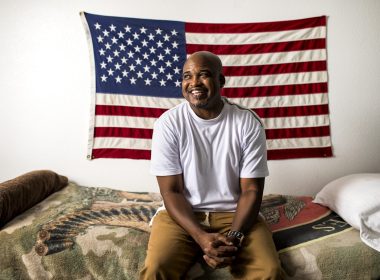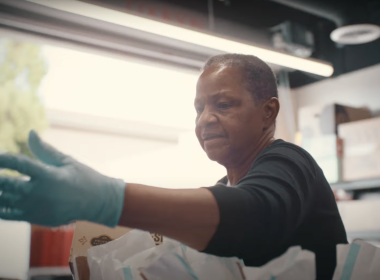A Scripture study from Caring, part two of five.
Read part one here.
Part 2: He is Hope
Behind the scenes
Read what Scripture says in Matthew 16:13-20.
Beyond the surface
In Matthew 16:13-20, Jesus takes his disciples on a journey to Caesarea Philippi. He asks them, “Who do the people say I am?” Then there is a follow up question, “What about you? Who do you say I am?”
Peter responds with, “You are the Christ, the son of the living God” (Matt. 16:16). Affirming Peter’s response, Christ proceeds to convey he will overcome the “gates of hades” (meaning the authorities, deities and powers) which stand against the work of building up his church. This will require faith from his disciples, because in this specific time and place, it’s difficult to see the work of Christ.
For context
It’s all about the location:
Why did Jesus choose to ask this question in Caesarea Philippi? Located at the luscious and fertile base of Mt. Hermon, water flowed down from the mountain and provided refreshing springs to this area.
Prior to taking the name Caesarea Philippi, the city was called “Panion,” meaning, “the Sanctuary (or worship center) to Pan,” according to the Archaeological Study Bible. Pan was a pagan god associated with fields and herds, and the location served as a spot for emperor worship. Also, there were caves of flowing water there.
Prior to the worship of Pan, Baal was also worshipped at the location. Scholars believe this may be the same city as the Old Testament city “Baal-Gad” or “Baal Hermon,” according to Bible Backgrounds Commentary.
Think about it
In our journey with Christ, it’s not a question of “if” we will come to a place where we need to ask ourselves, “Who is Jesus?” Rather, it’s when and where.
Here they are. They are standing in Caesarea-Philippi, a place of Baal worship in Old Testament times and the worship of Pan, in the New Testament era. This is a prime location for Christ to ask the question. After all, many people believed Baal (in the Old Testament era) and Pan (in the time of Christ) made the land fertile and prosperous.
This worship may have looked good. Temptation challenges our faith with seemingly logical ideas and correlations that stand against our faith in Christ.
Who is Jesus?
It’s not a matter of what you believe, but where and when do you believe what you believe?
Where do you confess Christ? Christ wanted to know what they believed in the presence of Caesarea Philippi where it would require faith in the seemingly unseen work of God.
The title, “Christ,” refers to the heir to David’s throne. This meant hope for those who longed for the expected one to rule on David’s throne. From 2 Samuel 7:14, God promised this would be fulfilled through His own Son. By using the term, “the living God,” Peter is expressing that God is alive, even in the midst of the surrounding context of Emperor worship, Pan worship and Baal worship.
Christ is hope because he will break down and build up. He says to Peter, “You are Peter (petros), and upon this rock (petra) I will build my church” (Matt. 16:18).
“Petros” refers to “a detached stone” and “petra” refers to bedrock, or “a mass rock…used as a sure foundation,” according to Vine’s Concise Dictionary of the Bible.
Hope is found in the living God through Christ, and when we confess Christ as Lord.
Peter would later remind us of this promise found in one of his letters.
“Praise be to the God and Father of our Lord Jesus Christ! In his great mercy he has given us new birth into a living hope through the resurrection of Jesus Christ from the dead” (1 Peter 1:3).
“See, I lay in Zion a stone, a chosen and precious cornerstone; and the one who believes in him will never be put to shame” (1 Peter 2:6).
Between the lines
Christ promised the gates of hades cannot withstand the work of the church. “Gates” refers to the strength, might and security of hades and sheol. It is by faith and God’s kingdom through Christ that we will prevail.
While idolatry is not always evil by appearance, it can be anything we put our hope and trust in apart from Christ.
Christ is known as our living hope. The purpose of Christ is that hope will be found within the church.
As a church, we are to:
- Worship God
- Live for God as a community of God’s people
- Act out God’s mission through exemplifying hope and faith
- What is your Caesarea Philippi? What is the place that tempts you and distracts you from putting your hope in the living God through Christ?
- In what aspect of your life are you required to put faith and hope in Christ, even when it’s difficult to see what God is doing?
- As a part of the church, how can you personally participate in reaching places in need of the hope of Christ?
Sign up for the Do Good Digest, our weekly newsletter, and stay tuned next week for part three.
Do Good:
- Download the full study and find more like it from Caring in the Scripture study library.
- Visit westernusa.salvationarmy.org to find The Salvation Army nearest you.
- Give to support the fight for good in your community.
- Do you have a hard time telling people what you do, or what you’re passionate about and why? Ever stared at a blinking cursor, unsure of what to say or where to start? Or do you avoid writing altogether because you’re “not creative enough”? Take our free email course and find your story today.













Comments are closed.